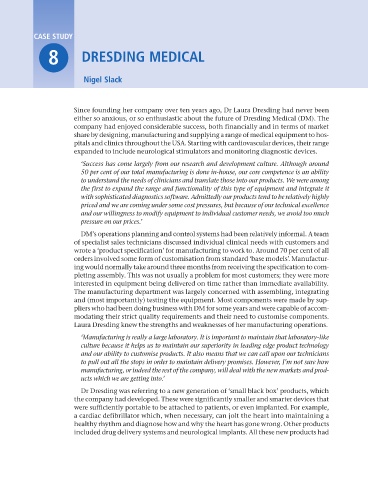Page 437 - Operations Strategy
P. 437
case stuDy
8 DresDing meDical
nigel slack
Since founding her company over ten years ago, Dr Laura Dresding had never been
either so anxious, or so enthusiastic about the future of Dresding Medical (DM). The
company had enjoyed considerable success, both financially and in terms of market
share by designing, manufacturing and supplying a range of medical equipment to hos-
pitals and clinics throughout the USA. Starting with cardiovascular devices, their range
expanded to include neurological stimulators and monitoring diagnostic devices.
‘Success has come largely from our research and development culture. Although around
50 per cent of our total manufacturing is done in-house, our core competence is an ability
to understand the needs of clinicians and translate those into our products. We were among
the first to expand the range and functionality of this type of equipment and integrate it
with sophisticated diagnostics software. Admittedly our products tend to be relatively highly
priced and we are coming under some cost pressures, but because of our technical excellence
and our willingness to modify equipment to individual customer needs, we avoid too much
pressure on our prices.’
DM’s operations planning and control systems had been relatively informal. A team
of specialist sales technicians discussed individual clinical needs with customers and
wrote a ‘product specification’ for manufacturing to work to. Around 70 per cent of all
orders involved some form of customisation from standard ‘base models’. Manufactur-
ing would normally take around three months from receiving the specification to com-
pleting assembly. This was not usually a problem for most customers; they were more
interested in equipment being delivered on time rather than immediate availability.
The manufacturing department was largely concerned with assembling, integrating
and (most importantly) testing the equipment. Most components were made by sup-
pliers who had been doing business with DM for some years and were capable of accom-
modating their strict quality requirements and their need to customise components.
Laura Dresding knew the strengths and weaknesses of her manufacturing operations.
‘Manufacturing is really a large laboratory. It is important to maintain that laboratory-like
culture because it helps us to maintain our superiority in leading edge product technology
and our ability to customise products. It also means that we can call upon our technicians
to pull out all the stops in order to maintain delivery promises. However, I’m not sure how
manufacturing, or indeed the rest of the company, will deal with the new markets and prod-
ucts which we are getting into.’
Dr Dresding was referring to a new generation of ‘small black box’ products, which
the company had developed. These were significantly smaller and smarter devices that
were sufficiently portable to be attached to patients, or even implanted. For example,
a cardiac defibrillator which, when necessary, can jolt the heart into maintaining a
healthy rhythm and diagnose how and why the heart has gone wrong. Other products
included drug delivery systems and neurological implants. All these new products had
Z08 Operations Strategy 62492.indd 412 02/03/2017 13:46

